Growing Pecans & Growing an Industry in South Africa
As the world's third largest pecan producer, South Africa continues to tap into its production potential with new plantings that build off of historical efforts.
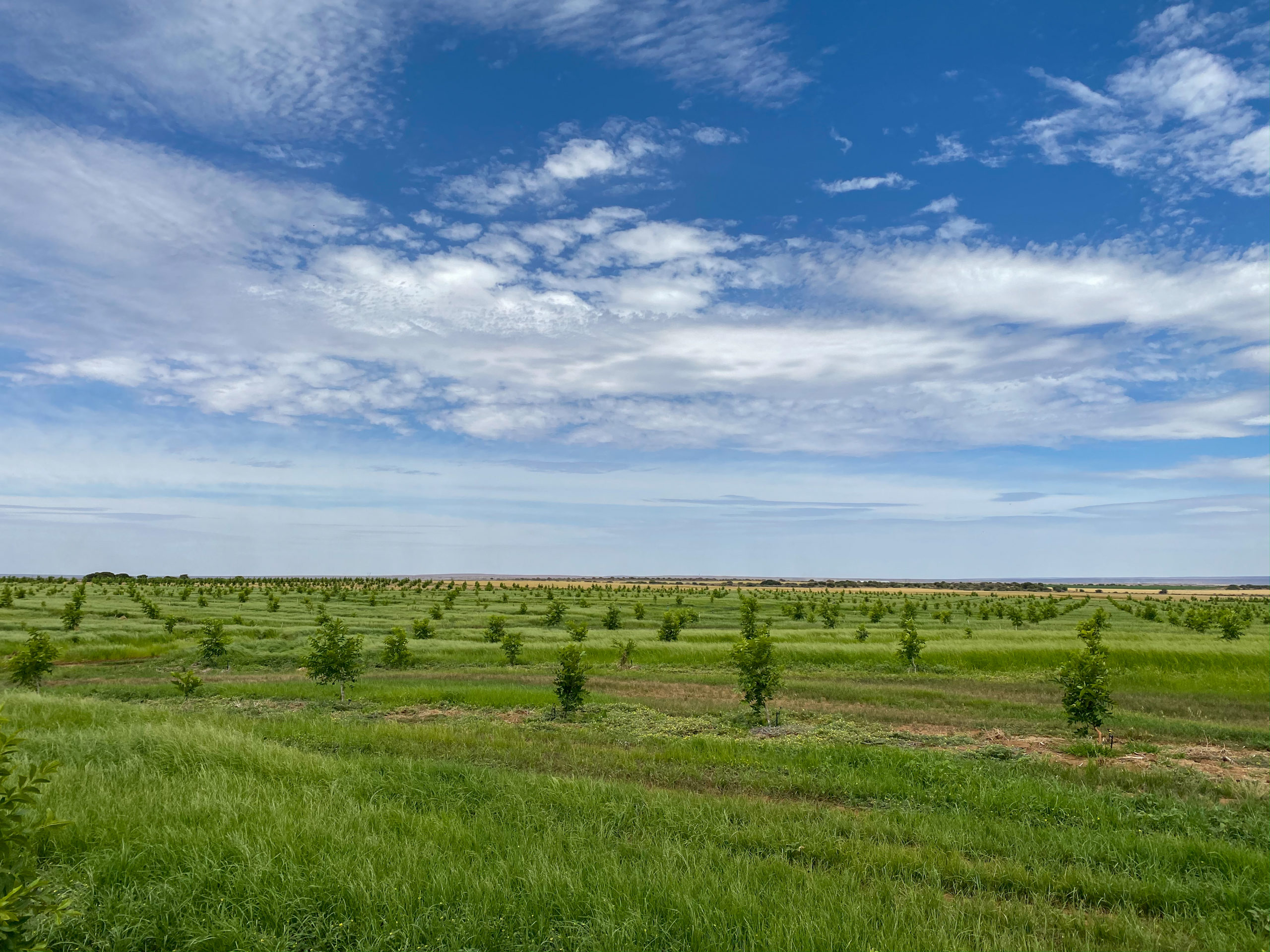
The newest plantings at Ernie Steinberg’s young plantings in Douglas, Northern Cape, South Africa, grow among other crops like potatoes and wheat. Steinberg is slowly planting pecan trees on his land and hopes to have about 1,483 acres. (Photo by Blair Krebs)
It was our second day in South Africa, and after a good night’s rest and some makeup, I was finally starting to feel—and look—human again.
You can never really prepare for what a 30-hour journey to another hemisphere, another continent, and another country will do to you. Sure, Blair, Pecan South’s publisher, and I had heard the stories from past travelers. Crossing oceans and time zones, we’ve even been those travelers before. But the journey to South Africa, the world’s third-largest pecan producer, took something different out of us.
Two weeks before Thanksgiving 2019, we traveled over 8,900 miles to attend SAPPA’s annual conference, meet with pecan growers, and learn more about a flourishing pecan industry.
Since the late 1990s, South Africa went from producing only 2 percent of the world’s pecans to 7 percent. From a different perspective, South Africa’s pecan production grew from 5,800,000 pounds in 2006 to 36,462,000 in 2018. That’s a 529 percent increase!
Production is booming. And that boom is expected to continue.
In 2017, the American Pecan Council used a third-party consultancy to research and collected data on the pecan industry. After conducting industry interviews, aggregating data, and surveying stakeholders, the APC forecasted that South African pecan production would continue to flourish over the next decade and would “comprise more than 10 percent of world supply” at around 145 million pounds by 2027.
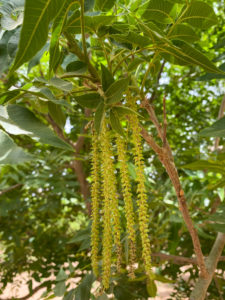
Catkins hang off a pecan tree in an orchard between Douglas, Northern Cape, South Africa, and the Orange River. (Photo by Blair Krebs)
Just as their North American counterparts look forward to a bright future, South African growers also see a chance for great success and strive to capture their fair share of the market.
Before examining South African pecan growers’ current situation, I want to use this first article to take a step back to the beginning of the South African pecan industry. While American and Mexican pecan producers draw pride from a history that stretches back to their indigenous populations, South African growers trace their pecan roots to the late 19th century.
Dr. Fred R. Brison documents in his 1974 book Pecan Culture that a nurseryman from Natal, known as Mr. Wilkinson, introduced pecans to the Union of South Africa, now the Republic of South Africa, in the final years of the 1800s.
“The thrift of these trees and appeal in 1921 of Tribolet, Chief Horticulturist, ‘…to awaken the interest…of more progressive fruit growers…to take up the culture of the finest edible nut grown in any part of the world’ gave further impetus to pecan growing,” Brison wrote.
As the years passed, this interest only grew.
A key figure in the industry’s origins, Hugh Lanion Hall established the oldest and first commercial pecan operation in South Africa in 1913 outside of Nelspruit, now called Mbombela, a town located in the Mpumalanga province.
Over the years, H.L. Hall and Sons developed the country’s largest orchard, which included ‘Frotscher,’ ‘Moore,’ ‘Barton,’ ‘Curtis,’ and other varieties. According to Pecan Culture, H.L. Hall and Sons had about half the pecan trees in South Africa in the early 1970s. In 1972, Hall had about 885 acres with 35,000 trees. Brison also wrote that the Halls adopted close spacing and anticipated an eventual tree population exceeding 70,000 “with a production potential of one million pounds…annually.”
Following Hall’s example, other farmers established commercial plantings in the provinces of Mpumalanga and Limpopo, formerly called the Eastern and Northern Transvaal.
This early period of the South African pecan industry involved much experimentation, failure, and perseverance. Like any new crop, it took years—decades even—for farmers to gain confidence and produce a consistent yield.
In the late ’60s and early ’70s, professors Le Roux and Nigel Wolstenholme of the University of Natal in Pietermaritzburg began conducting the first commercial research on pecans. Roux and Wolstenholme established early trial orchards in Nelspruit, Roodeplaat, and at the University’s Research Station in Addo, and created a program to select seedling varieties. According to the article “The history of SAPPA and the South African pecan industry” on SAPPA’s website, Wolstenholme and Roux “by pure chance selected a seedling in their own orchard that they planted as rootstock.” This rootstock became the ‘Ukulinga’ variety that is now prolific throughout South Africa and remains especially popular as a rootstock and a scab-resistant variety.
After visiting Texas A&M University in 1969 and 1970, Wolstenholme proposed guidelines for selecting growing sites in South Africa. Outlined in the May 1977 issue of The Pecan Quarterly, these guidelines specified that the production area must be sufficiently hot in the summer and through the seven-month nut growing period (from October to April); sufficiently cold in the winter (June, July, and August being the coldest months); and lastly, the area should preferably have “a deep medium-textured alluvial riverbank soil.”
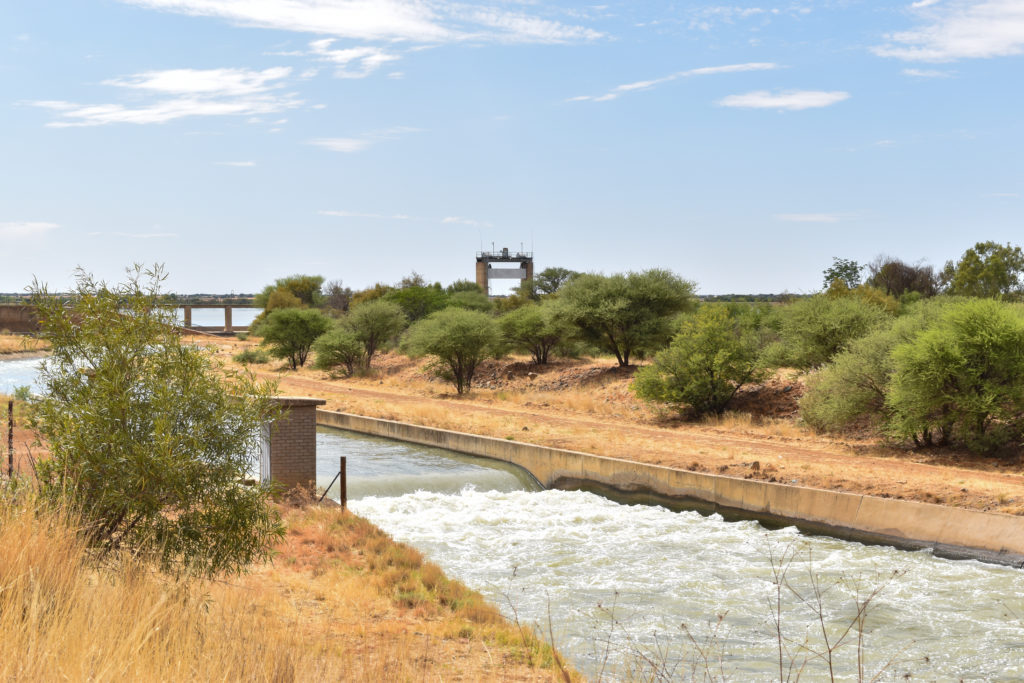
One of the dams that collects and releases water into the Vaalharts Irrigation Scheme, which provides water to many orchards in the Northern Cape. (Photo by Catherine Clark)
With these guidelines in mind, Wolstenholme predicted that the South African pecan industry would shift west. Brison shared this sentiment.
“Climatic conditions in the central Orange River Valley and parts of East Cape Province are similar to the warm continental climate in the Southern United States where pecans thrive,” Brison wrote in 1974. “This is a promising potential area for pecans particularly in the interior of the eastern East Cape Province.”
And so, the University of Natal encouraged the establishment of small pecan test orchards by Oom Pietie Roux, Albert Boumeester, and Michael Antrobus in Hopetown, Cullinan, and Cradock, respectively.
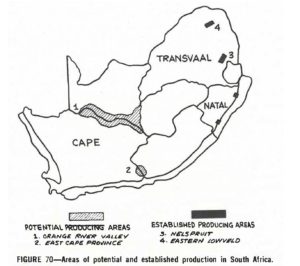
From Dr. Fred R. Brison’s 1974 book Pecan Culture, this figure exhibits the established pecan producing areas and potential production areas in South Africa at the time of printing. These potential areas are now the heart of the country’s pecan production.
During this period, South African growers showed interest in the U.S. Department of Agriculture’s new varieties—‘Wichita,’ ‘Choctaw,’ and ‘Barton.’ In the May 1977 issue of The Pecan Quarterly, Robert A. Pearson wrote about his “novel pecan venture in the province of Natal.” Within his article, titled “Pecans Grow in Africa,” Pearson said that “in the last ten years or so interest [in pecans] has been increasingly high, and many new trees of the USDA varieties have been planted.” The three mentioned varieties remain popular throughout the country’s current major production region in the Northern Cape.
Although interest was high, one particular problem kept growers from planting as many trees as they could. The “expansion is restricted only by the shortage of nursery trees,” Brison explained in Pecan Culture.
Addressing the lack of nursery trees, the Institute for Tropical and Subtropical Crops developed a program to connect potential growers and nurserymen with information on pecan production. According to “The history of SAPPA and the South African pecan industry,”
Johan Oosthuizen helped new growers establish their own nurseries to produce trees for themselves and others.
Although the burgeoning South African pecan industry had thousands of trees planted and decades of experience, it felt a need to unite further and find more knowledge to help the industry and farmers. So, in 1991, the Institute for Tropical and Subtropical Crops arranged a stakeholders meeting in Nelspruit; this meeting birthed the South African Pecan Nut Producers’ Association (SAPPA).
In the next few years, SAPPA worked to support growers, but years of political isolation left South Africa with outdated information. Pecan grower Heiko Meier wrote in “The history of SAPPA and the South African pecan industry” that a SAPPA board member suggested a pecan information tour in the United States; with limited resources and no previous experience, Meier said that he “faxed requests to visit, mostly to fax numbers picked up in Pecan South.” Four members journeyed to the U.S. and spent two weeks jumping from pecan research facilities to nurseries to large growing operations to processing facilities. Meier said that this tour launched the pecan industry in South Africa into a new era.
Since then, the South African pecan industry has further blossomed. SAPPA helped establish connections with researchers in the U.S. who visited and shared their information; a working relationship between Stahmann Farms in Australia and SAPPA also contributed to the industry’s growth.
During this time, new and more extensive plantings continued to pop up, and the industry slowly moved West, chasing more sun and water and open space. Meier explained in “The history of SAPPA and the South African pecan industry” that this shift came with some changes as well. The once-dominant Hall and Sons sold most of their pecan orchard property; many orchards in Zululand and Lowveld were sold back to the government as part of its land redistribution program; the Institute in Nelspruit and Roodeplaat “lost their edge and focus on quality pecan research,” after shifting their focus to educating subsistence farmers.
Now, 80 to 90 percent of South African pecan production resides in the Northern Cape, specifically around the cities of Upington, Prieska, Douglas, and Hartswater. In this western province, farmers buy up nursery trees left and right to plant as many pecan trees they can afford to take on financially and physically.
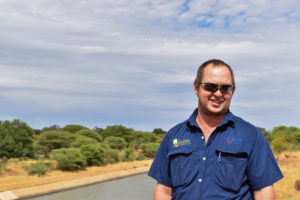
Hardus du Toit’s bakkie, or truck, waits while we tour one of his family’s orchards. (Photo by Catherine Clark)
It was this region that Hardus du Toit drove Blair and me through during our jam-packed visit. We spent about two days at SAPPA’s Annual General Meeting and Information Day in Modimolle, Limpopo, and then crossed to the other side of the country to the western production region.
On a bright morning in Kimberley, we piled into du Toit’s white bakkie (truck) and started our tour, where we visited orchard after orchard and along the way, passed new plantings and established operations. Much like Las Cruces, New Mexico, there was a pecan orchard everywhere we looked.
“You’ve got farmers with trees and you’ve got tree farmers,” du Toit explained to us as we passed a parcel of row crops with a couple of rows of pecan trees in the far corner. Seeing the financial opportunity in pecans, many local farmers are slowly switching over from other crops—like maize and wheat.
During those few days, we met with tree farmers. They showed us their trees, discussed their greatest challenges, and expressed their hope for a future of collaboration and steady production. Stefan Smith shared the story of his grandfather, who returned from World War II and began farming on government-gifted land. Jannie Smit told us about the nursery he established when he started planting his trees. And Dries DavenHague explained how South African pecan producers lack government support and must move the industry forward themselves.
Their stories and their concerns added color to my black-and-white understanding of the South African pecan industry, and I hope they do the same for you. The next article in the March issue of Pecan South will dive deeper into our visit to South Africa and growers’ current production and challenges. For now, I’ll leave you with this history that shows us that the ties between our countries and industries started long ago. These connections have enabled us both to prosper, learn, and achieve new heights. The global pecan industry is a living thing, and much like the tree you all grow, this industry endures setbacks, relies on its roots to ground it, and reaches for the sky.

